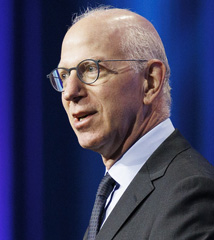


Howard Sandler, MD, MS, FASTRO, ASTRO President introduced this year’s topic as GU cancers, noting his presidential prerogative to designate an exploration of three areas: prostate, renal and bladder cancers. Today’s Symposium serves as a catalyst to applying these strategies straightaway in clinical practice.
Shankar Siva, PhD, MBBS, moderated Session I on the Renaissance of Radiotherapy for Renal Cell Carcinoma (RCC). Dr. Siva asked, is stereotactic ablative body radiotherapy (SABR) “ready for prime time?” Dr. Siva defined primetime as a treatment at center stage, one ready for discussion at a tumor board meeting and a viable option for patients. He noted enablers to achieve such status include understanding the history and evidence, its optimal dose, the role of post RT biopsy and optimal post-treatment schedule. Dr. Siva encouraged: “As a community let’s be invigorated by our findings. The future should undertake randomized trials of SABR vs. surgery. SABR for RCC IS ready for primetime.”
Chad Tang, MD, provided context, with global increase of RCC, especially for patients above age 70. Enter SABR as a possibly suitable alternative, a high precision technique with millimeter accuracy. For secondary spread, SABR provides durable disease control and valuable adjunct to drug therapies. Rana McKay, MD, provided the medical oncologist perspective on different scenarios. For the oligometastatic patient who is treatment naïve, she advised applying IMDC criteria to inform prognosis. The image was presented of how histologies have been thrown into one grab bag despite the distinct responses each might have to SBRT. “We need more clinical trials that actually look at SBRT and its impact on different histologies.” Dr. McKay highlighted: “Congrats to ASTRO for elevating the work that has been done. We need more studies that demonstrate SBRT’s impact; enter the data into guidelines; educate our community, physicians, and clinicians; encourage multidisciplinary conversations, engage patients. It all starts with investing in clinical research.”
Leslie Ballas, MD, moderated Session II, “Bladder Preservation – A Modern Choice for Patients,” providing updates on trimodality therapy (TMT). She opened with the timeline for bladder cancer, that little has changed regarding cystectomy as treatment. While organ preservation techniques are common for other cancers, for the bladder, physicians have viewed radiation as too toxic. The tipping point for bladder preservation occurred from a study with a cohort of over 1,100 patients. A sea change is happening, with cystectomy no longer the gold standard, and for the properly selected population, TMT is the appropriate approach. Drivers have been clinical trials — with two more NRG randomized trials coming soon, guidelines, and those behind them, including Dr. Sandler, Jason Efstathiou, MD, PhD, FASTRO, and Siamak Daneshmand, MD.
Ananya Choudhury, PhD, shared the practical use of bladder radiation, that is, the “dawn of a more personalized radiotherapy.” We now have the technology to adjust to the shift-changing of the bladder and that adaptive therapy improves the coverage of the planned target volume (PTV). Now is the time to personalize further, choosing the correct radiosensitizer for the patient and making that part of the treatment pathway.
Gopakumar Iyer, MD, closed out the session on bladder cancer by exploring the integration of novel therapeutics with TMT. This included looking at data for antibody-drug conjugate therapy combined with radiation in preclinical bladder cancer models.
Session III was facilitated by Ronald Chen, MD, MPH, FASTRO, on “Radiotherapy for Prostate Cancer: Innovations You Can Implement Today.” He navigated this session on microboost developments, salvage therapy options for patients who develop a local recurrence after definitive radiation therapy and treatment for oligometastatic prostate cancer.
Brandon Mahal, MD, specifically covered microboost, on dominant lesions in the prostate with external beam radiotherapy. Future considerations to optimize microboost paradigm include defining optimal margin and boost dose, clarifying risk of urethral toxicity. Dr. Mahal’s optimism was evident: “I sincerely believe we’re arriving at the golden era of modern radiation oncology and emerging techniques, while improving prostate microboost feasibility.”
Dr. Chen reviewed salvage therapy options for patients who develop a local recurrence after definitive radiation therapy. Finally, Phuoc Tran, MD, PhD, delved into the topic of oligometastatic SBRT, summarizing that space and time in mCSPC are clinical manifestations-phenotypes that are correlated with outcome and can direct treatment. Understanding the underlying biology better can instruct rational design of combination, systemic and local therapy for metastatic disease.
Dr. Sandler closed the Symposium, remarking upon his initial goal to make this the “best Symposium ever.” The objective was to focus on innovations achievable upon returning to the office. Personalizing practice to the individual patient level, Dr. Sandler shared: If one more kidney cancer patient can be treated with SBRT, or a prostate cancer patient have radiotherapy applied as a salvage modality or a bladder cancer patient have their physician advocate for bladder preservation/sparing, then, truly, the goal was achieved.